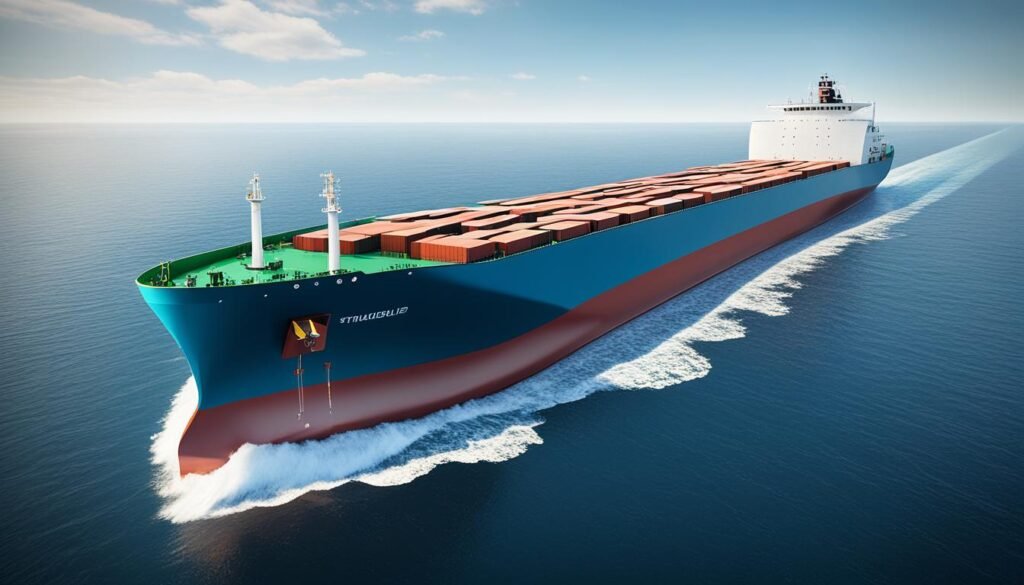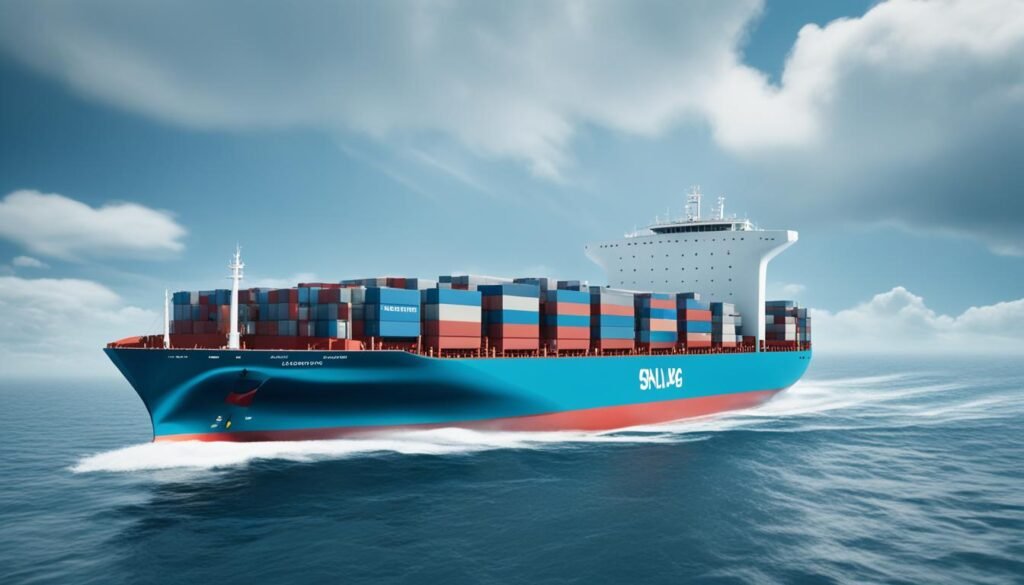As a seasoned maritime professional, I’ve seen firsthand the struggle to keep fuel costs down while keeping ships running smoothly. It’s a tricky balance. But, there’s a simple solution that could change everything. It’s called cargo ship trim optimization, and it’s a game-changer.
Imagine boosting your vessel’s fuel efficiency by up to 5% without big changes or high costs. That’s what trim optimization offers. It’s a quick way to see big savings, often in just 1 to 6 months, based on your ship’s details.

But it’s not just about saving fuel. Optimizing your ship’s trim also cuts down on resistance, boosts speed and range, and makes your ship more stable. Plus, it reduces emissions, making it better for the environment. It’s a win-win-win that’s hard to ignore in today’s maritime world.
Importance of Trim Optimization
Ensuring a cargo ship’s stability, efficiency, and draft is key to its success. Managing the ship’s trim is a big part of this. Trim is the difference in draft between the aft and forward of the ship. Getting it right can greatly improve fuel efficiency, emission reduction, and voyage planning.
Trim optimization aims to cut down on power needed and boost efficiency by reducing resistance and increasing propulsive efficiency. This is done by managing weight distribution, ballast management, and vessel trim calculation. Advanced voyage planning software helps make better decisions.
By focusing on trim optimization, cargo ships can use less energy and be better for the environment. This helps the industry cut down on emissions and fuel use. It’s key to a sustainable future in maritime transport.
| Key Factors in Trim Optimization | Potential Benefits |
|---|---|
| Vessel stability Hydrodynamic efficiency Draft optimization Voyage planning | Improved fuel efficiency Reduced emissions Enhanced operational economics Increased environmental sustainability |

Theoretical Principles of Trim Optimization
Optimizing a cargo ship’s trim is key to saving fuel and cutting down on pollution. The main idea is to lower the ship’s resistance. This is done by tweaking several important factors. The ship’s resistance is calculated using the formula R_T = 1/2 ρ V^2 S C_T. Here, S is the area underwater and C_T is the resistance factor. By making these areas and factors smaller, you can make the ship move more efficiently and save fuel.
Resistance Reduction
The ship’s resistance changes due to its wetted surface area and resistance coefficient. The wetted surface area doesn’t change much, but the resistance coefficient can change a lot. This means the ship’s resistance can go up or down by a lot, affecting how much power it needs.
Also, changing the trim affects the ship’s thrust and wake. These changes can make the ship use up to 5% more or less power. Finding the right balance is key to making the ship sail more efficiently.
| Parameter | Variation Range | Impact on Power Requirement |
|---|---|---|
| Residual Resistance Coefficient | ±150% | ±20% |
| Thrust Deduction | Up to 15% | Up to 3% |
| Wake Fraction | Up to 5% | Up to 5% |
Using these theories, ship operators can make their ships more efficient. They can use trim optimization algorithms to reduce hull resistance minimization. This leads to better vessel motion monitoring and vessel trim optimization. The result is big improvements in fuel-efficient sailing and hydrodynamic performance.

Cargo Ship Trim Optimization
Trim optimization is key to making cargo ships more fuel-efficient. It can be done through model tests or using computational fluid dynamics (CFD). CFD is cheaper than physical model tests but gives similar results.
Optimizing trim means looking into what affects a ship’s performance. Factors like wetted surface area, waterline length, and propeller efficiency matter. By tweaking these, ships can use less fuel and emit less pollution.
| Metric | Fuel Savings Potential |
|---|---|
| Trim and Draft Optimization | 0.5% to 3% reduction in main engine fuel consumption for most ship types |
| Partial Load Vessels (Container Ships, Ro-Ro) | Up to 5% reduction in fuel consumption |
| Tankers and Bulk Carriers | Less significant reduction due to higher viscous resistance |
| Car Carriers | Potential savings of over 20% in extreme cases, subject to operational limitations |
Installing trim optimization systems and training crew costs between $15,000 to $75,000 per ship. After setup, there are no extra costs. This makes trim optimization a smart way to make maritime transport greener.
Efficiency Gains through Trim Optimization
Trim optimization is key to making cargo ships use fuel more efficiently. The way a ship moves through water changes when its trim is adjusted. This can lead to big savings in power and fuel.
Propulsive Efficiency Factors
The thrust deduction, a big part of how efficiently a ship moves, can change by up to 15% with trim adjustments. This means power use can change by up to 3%. The effective wake fraction also changes, going up by up to 20% for bow trims and down by up to 10% for stern trims. This can lead to power changes of up to 5%.
Tests show that changing the trim can make a big difference in how much power a ship uses. These tests look at five even keel conditions and five trimmed conditions. They also look at the five to six speeds the ship can go.
Container vessels and LNG carriers see the biggest impact from trim changes. The way the bulbous bow of the ship goes underwater affects its performance a lot. The results show how much power a ship saves or uses more than when it’s even keel.
Trim optimization can save up to 15% in fuel at the best conditions. Usually, it saves around 2 to 3% in real-world operations. This means big cost savings and less environmental harm, making trim optimization important for eco-friendly shipping.
Integrating Trim Optimization into Ship Operations
To get the most out of vessel trim adjustment, it’s key to blend this info into the ship’s loading computer software. This way, the best vessel draft management and trim are figured out automatically. It takes into account stability, strength, and how the ship moves.
But, there are some operational constraints and limitations to using hydrodynamic optimization. Some loading conditions have rules that must be followed before making changes. The trims, drafts, and speeds picked for the study should be practical to use. This makes the study cost-effective and boosts seakeeping performance enhancement and efficient cargo distribution.
Balancing Operational Realities
Tonnage distribution analysis and hydrodynamic load balancing can greatly improve voyage fuel efficiency. But, we must think about how to use these methods in real life. Safety, port rules, and how to handle cargo might stop us from using the best trim and draft all the time.
By adding trim optimization data to the ship’s loading software, operators can find a good balance. They can use the best trim and draft without ignoring maritime operational efficiency challenges. This way, they make the most of voyage fuel optimization without risking safety or how well the ship works.
| Statistic | Value |
|---|---|
| Fuel savings from trim optimization | Up to 5% |
| Fuel savings for a 2000 TEU container feeder at 22kn | Approximately 35 barrels of oil per day |
| Potential fuel consumption reduction range | 0.5% to 3%, up to 7% in extreme cases |
| Shaft power savings per 0.50 meters of trim adjustment | 1% to 2% |
| Difference in shaft power with 0.50 meters trim change | 6% to 8% |
The Future of Trim Optimization
The maritime industry is focusing more on saving fuel and being green. Studies show that small changes in a ship’s initial trim can make a big difference. This means trim optimization is a great way to cut costs and reduce emissions.
Advancing Trim Optimization Methods
Now, the industry aims to optimize beyond just one design point. They look at various displacements, draughts, and speeds. This lets them optimize better for different situations.
CFD and simulation tech are getting better, making trim optimization more precise and affordable. These tools can work with ship-loading software for real-time advice on the best trim and draft settings.
New techs like AI, machine learning, and data analytics are boosting ship trim optimization. These tools can sift through lots of data to find the best trim settings. They also predict how changes will affect a ship. As the maritime world gets more digital, these technologies will lead to more growth and innovation in trim optimization.
Conclusion
Trim optimization is key to making ships use less fuel and emit less pollution. By adjusting a ship’s draft and trim, operators can greatly improve how well the ship moves. This leads to big savings on fuel and helps the environment.
Research shows that ships can save up to 15% of fuel by optimizing trim. This means a 2 to 3% savings for all ships. Big ships like oil and bulk carriers can use 10-15% less power when empty and 5-8% less when full.
Trim optimization does more than just save fuel. It also makes ships move better, stay stable, and carry cargo more efficiently. These benefits help make shipping more sustainable and efficient, supporting the goal of greener seas.
The future of trim optimization looks bright with new technologies. Tools like computational fluid dynamics (CFD) and OpenFOAM give ship operators deep insights. This helps them make better decisions and save even more.
In summary, mastering trim optimization is a big win for the shipping industry. It’s a cost-effective way to use less fuel, cut emissions, and support a sustainable future for global trade and transport.
FAQ About Cargo Ship Trim Optimization
What is trim optimization and why is it important for cargo ships?
Trim optimization makes ships run better and use less fuel. It doesn’t need changes to the ship’s shape or engine. Instead, it uses the right ballast or cargo loading. This can save a lot of money, taking just a few months to pay back.
How does trim affect a vessel’s propulsive performance?
Trim affects how well a ship moves through the water. It changes the resistance and efficiency of the ship. This can make the ship use up to 20% more or less power.
What are the key factors involved in trim optimization?
To optimize trim, we look at what affects a ship’s performance. This includes the wetted surface area, waterline length, and more. These factors help us find the best way to move the ship.
How can trim optimization be performed, and what are the typical energy savings?
Trim optimization uses model tests or computer simulations. It can save up to 15% in fuel at the right trim. Over a whole fleet, savings can be 2 to 3%.
How can trim optimization data be integrated into ship operations?
Trim data should go into the ship’s loading software. This lets the ship find the best trim and draft automatically. However, some loading conditions might not work well with trim optimization.
You can also read
